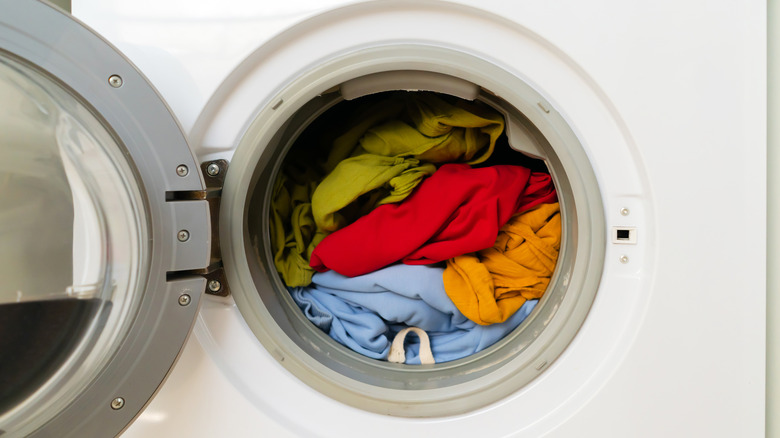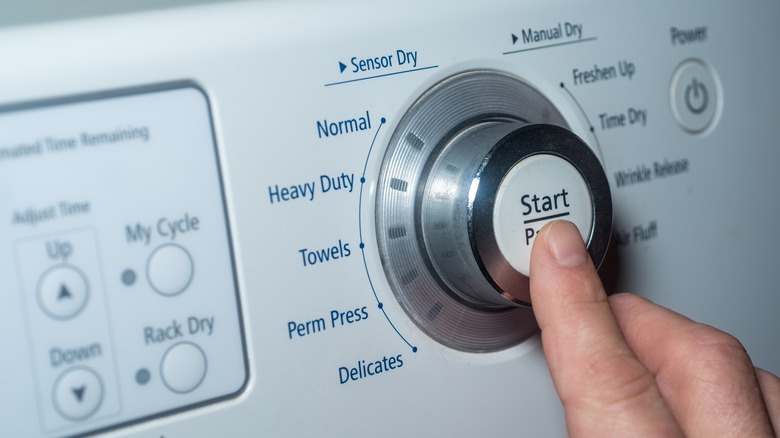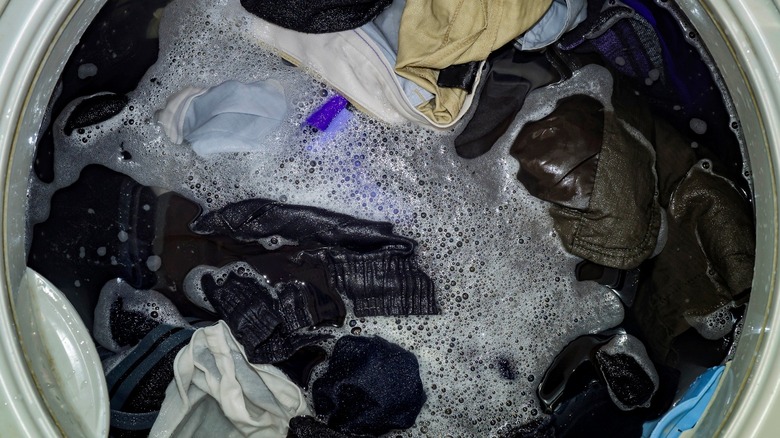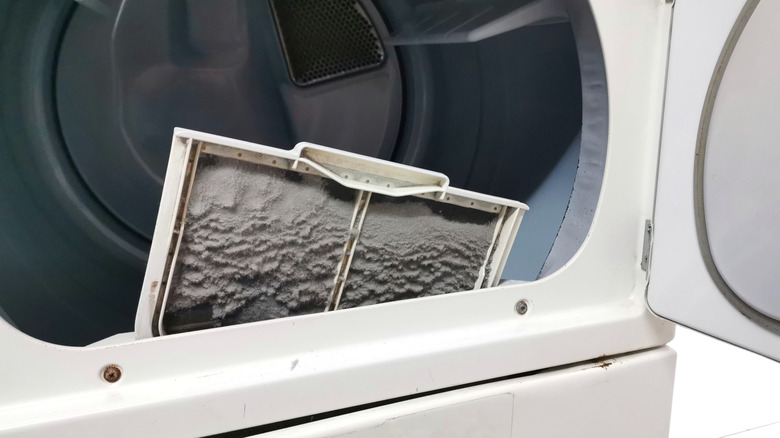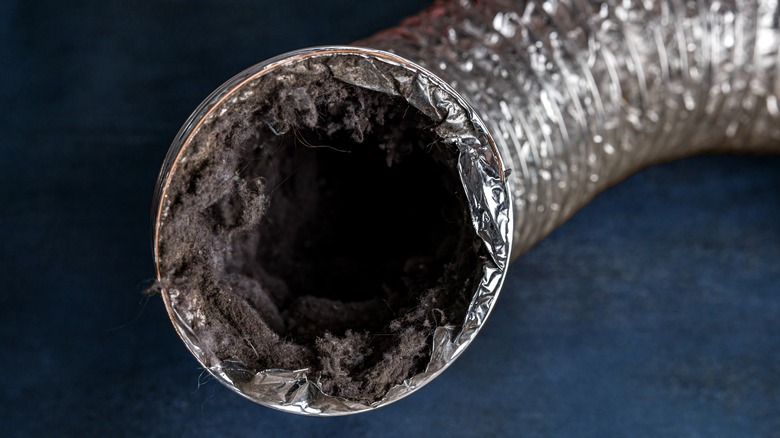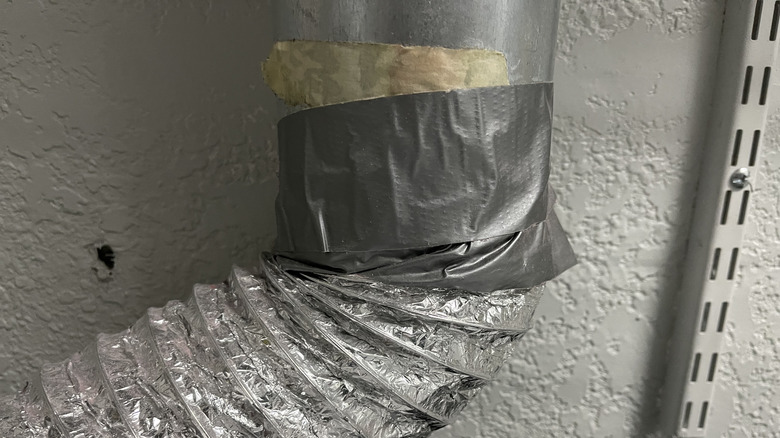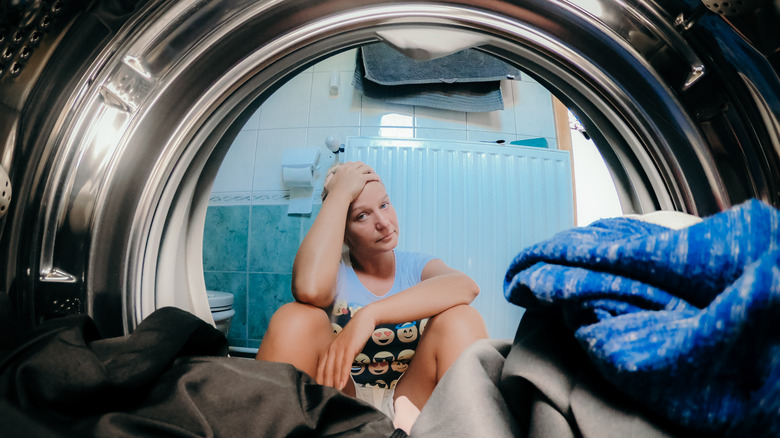Why Your Dryer Is Taking So Long To Dry Your Clothing (And What To Do About It)
A dryer can make finishing a load of laundry so much more convenient. You don't have to individually hang each item up and wait several hours for them to be dry. However, our appliances don't always function like we wish they would. If your model recently started taking a long time to dry a load of clothes, it can be both frustrating and puzzling. It can also be an energy-suck. Each load requires between 1.8 and 5 kilowatt-hours of electricity to complete. So, the more you run the dryer, the more electricity you use. Not only is this increasing your environmental footprint, but with a national average cost of 17 cents per kilowatt-hour, it also increases your electric bill.
Unfortunately, there is no one cut-and-dry (pun intended) answer for why your laundry takes so long to dry. There are several potential reasons that could increase the necessary cycle length. Continue reading to explore some of these reasons so you can diagnose — and remedy — your problem.
You're overloading the dryer
An overloaded dryer can't dry your clothes as quickly as one with a little more space. When the appliance is stuffed to the gills, the clothes will remain too tightly packed during each cycle, preventing the warm air from being able to circulate around them. Without that airflow, your clothes will likely remain damp after a standard cycle, making it necessary to run the machine a second (or even third time) before they're ready.
To avoid this problem, make sure you do not fill the drum more than three-fourths of the way. This means that the top fourth should be empty. This way, when the clothes tumble around during the cycle, there will be enough open space for air to circulate around them and dry them more quickly. Plus, ensuring you don't overload the dryer can deliver added benefits such as less wrinkled clothes and less lint.
You're not choosing the correct setting
With so many different settings and time options, understanding which one to select for each load can be confusing. However, if you don't choose one that is appropriate based on the clothing you're trying to dry, it can certainly cause it to take longer to finish each load of laundry. For example, if you're trying to dry a full load of towels and only select an air dry or even a low-heat setting, it is understandable that they may not be dry after one cycle.
To remedy this potential problem, it is a good idea to learn more about the various settings offered by your machine. This will help you make sure to choose an appropriate option that will have a much better chance of yielding a dry finished load. Fluff or air dry settings do not use any heat and are not really intended for drying items. Instead, they can help add volume to flattened pillows, remove dust from items, or just freshen things up to get them ready to wear again. A gentle cycle uses heat, but not very much. It is appropriate for silk, activewear, garments with embellishments, and other similarly delicate items.
Many loads will dry well with a permanent press setting. This option uses medium heat to dry clothes effectively. It also adds some last-minute room-temperature air at the end of the cycle to release wrinkles. If you're drying a load of towels or other bulky options, then a timed dry or regular setting may be best. This will allow the dryer to generate more heat and potentially run for a bit longer to accommodate bulkier loads. Finally, some models also have a steam cycle that integrates steam to help release wrinkles.
Your washing machine isn't spinning enough water out from each load
Sometimes, the problem you're facing may not actually be caused by the dryer. If your washing machine isn't spinning enough water from each load, then the items you're adding to the dryer are starting off wetter than they should. This will, understandably, cause the appliance to take longer to get everything dried.
The next time you move clothes from the washer to the dryer, take a second to note how they feel. If they feel overly wet or are dripping, then it is a sign that the washer may be to blame for the extended dry times. Check that the appliance is working properly and spinning out enough water. Consider hiring a professional if something seems amiss. If you have the money, you might also want to consider investing in a high-efficiency washer. These models will do a better job extracting more water during the spin cycle than older models.
You're not cleaning the lint screen often enough
Before you start a new load of laundry, do you clean the lint trap? If you answered "no" or "only sometimes," then you may have just identified why your laundry takes so long to dry. The lint screen catches the pieces of lint from clothing or linens in the wash. However, when it is full of lint, circulation throughout the machine can be impeded. With less circulation, your items aren't going to get exposed to enough air to dry as quickly.
Take just a few seconds before starting a load of laundry to empty the screen. Doing so is quite simple and can really deliver results and help prevent future problems, such as a clogged vent, which could potentially result in a house fire. Each dryer may have a slightly different layout, so the traps are not always in the same location. Many are right inside the door, while others may be along the back of the dryer or accessible from the top of the model.
In addition to removing the lint covering the filter after each use, it is also a good idea to give it a deep cleaning once every few months. This will remove residues, such as those from fabric softener, helping ensure that the filter can continue performing. To give yours a deep clean, gently scrub it with a soft brush dipped in hot water and dish soap. Before returning it to the dryer or starting a new load, be sure to let it dry completely.
The dryer vent needs to be cleaned
Just as you need to clean the lint trap to ensure that enough air is circulating through the machine, you also need to make sure that you don't neglect the dryer vent itself. When the hose becomes clogged with lint from multiple loads of laundry, the unit isn't going to function at peak efficiency levels. Enough warm air won't be able to reach the drum, which may make it necessary for you to give the dryer more time to finish each load than it should be taking. Beyond the drying times, a clogged vent poses a serious safety hazard. When you combine the fact that the machine gets very hot when it runs with how flammable the lint is, it is clear to see that you can create a recipe for disaster. Keeping the vent clean can decrease the chance of a house fire in your home.
A dryer vent should be cleaned at least once a year to remove the lint that has built up inside it. If you're comfortable doing so, this is a task you should be able to do on your own using a vacuum cleaner and a long brush designed for the job. However, if you're uncomfortable cleaning your dryer vent or would rather leave it to someone more experienced, you should find several vent-cleaning businesses in your area to choose from.
The dryer vent is damaged
A clogged dryer vent won't allow enough air into the appliance to efficiently dry clothing items. Likewise, a damaged hose will also stand in the way of your machine operating properly. If there are any holes or cracks in the vent hose, they'll impede the flow of air through it, adversely affecting the amount of air that can circulate your clothing. A damaged hose can also increase the fire risk.
If you've recently noticed that your machine isn't working as it used to, take a few minutes to inspect the vent hose. If you notice any cracks, signs of wear, kinks, or other damage, you may have identified the problem. While you may be able to patch some cracks or holes using tape specifically designed for dryer vents, it is nearly as easy, almost the same price, and more effective to replace the entire hose. Once you've attached the new hose to the dryer, ensure it is appropriately positioned and attached to the outside exit. If you're uncomfortable replacing the vent yourself, you can also call a local handyman or duct cleaning company to tackle this important task.
One of the parts isn't working properly
If you've tried all of the troubleshooting options shared above and your dryer is still taking too long to dry each load, then the problem may lie within the appliance itself. As with other appliances that you use, the various dryer components can wear out or fail over time. Several of these potential problems can result in extended drying times. For example, if the door or drum isn't sealed properly, too much heat will leak out during each drying cycle. The heating element may also burn out or become too dirty to function properly.
If you suspect something is wrong with the machine itself, then you'll likely want to contact an appliance repair company. If your model is still under warranty — either from the manufacturer or an extended warranty you added on when you purchased it — start there. A professional can diagnose the problem, determine what parts are required to fix it, and share a quote to complete the work. Depending on the age of your dryer and how much fixing it will cost, you may decide that purchasing a new model will be more cost-effective in the long run.

